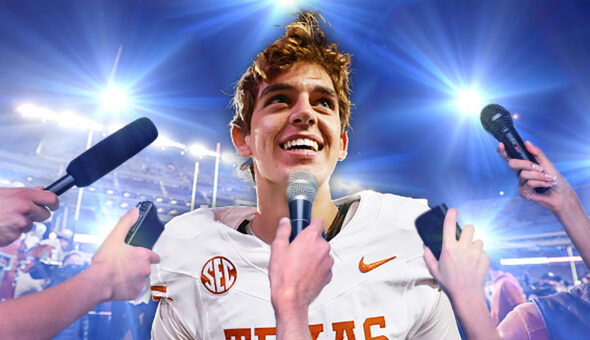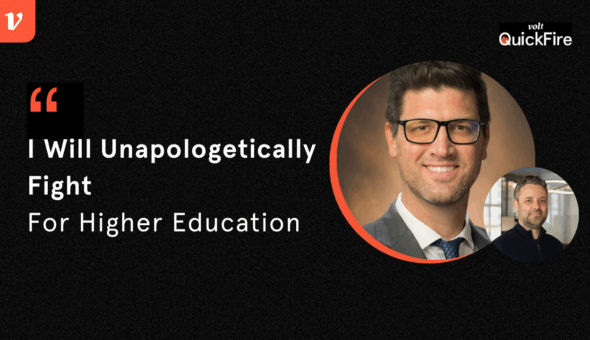Higher education marketing professionals know all too well that there are some stiff headwinds out there, and colleges and universities face intense competition to communicate their core values and attract the right prospective students.
The challenge? Reaching diverse audiences, including alumni and prospective students, within budget, while overcoming technological and cultural forces that challenge the very purpose of higher education and how it is delivered.
It is a difficult job, but it is doable — and necessary. Those who succeed will utilize innovative digital strategies, adapting to the latest trends in higher ed marketing to stay competitive and connect with today’s highly discerning prospective students.
With that in mind, these are nine of the top trends in higher education marketing for 2024.
(Want to see how these trends have evolved in 2025? Check out our latest insights on the shifting landscape of higher ed marketing and leadership here.)
1. Embracing Personalization
A Morning Consult report recently revealed that Gen Z and Millennials are notably less trusting of the average brand. After tracking nearly 2,000 brands, the report found Gen Z had half the trust towards the average brand, compared to previous generations.
To compensate for this response from their target demographic, universities have begun putting a high price on personalizing their marketing campaigns to reach and win the attention of prospective students. Personalization has become a key aspect of marketing across various industries, and higher education is no exception.
Institutions are utilizing data-driven insights to deliver personalized content, tailored messaging and individualized experiences to prospective students. From personalized emails to targeted social media campaigns, institutions are focusing on creating meaningful connections by addressing specific needs and interests.
2. Leveraging Influencer Marketing
Public disgruntlement about college’s perceived return on investment requires institutions to justify the extensive commitments of cost and time for traditional degree paths. The New York Times dug into this debate, describing universities as “out of touch with the society […] becoming ideological echo chambers.”
Continuously propelled by social media, influencer marketing continues to gain momentum in higher education as it has across all industry types. Recent data has shown that 92% of marketers believe that influencer marketing is an effective and sound marketing strategy.
By leveraging their credibility and reach, these influencers effectively promote programs, campus life and unique offerings to their engaged audiences, ultimately driving enrollment and building brand loyalty.
3. Harnessing Short-Form Video
The 21st century has undoubtedly been the era of social media, and it doesn’t show any signs of stopping. A recent Wyzowl poll showed that more than 91% of Americans want to see more video content from brands. There is also an ever-growing tendency for consumers to skip parts of audio and written content in favor of visual ones. Wyzowl’s data speaks for itself: consumers find short-form videos easily the most engaging type of content on social media.
In 2024, institutions are investing in high-quality short-form video production, including virtual campus tours, student testimonials and faculty interviews. The institutions then leverage these across platforms, such as Instagram and TikTok, to engage prospective students. Across the country, colleges are tapping into social media to give their videos a platform and have these reach a wider, younger audience.
Baylor University has an impressive track record with its social media presence by marketing some of the best aspects of the college, such as the stunning campus views on this recent TikTok video. Live streaming events and interactive webinars are also becoming more prevalent, enabling real-time interaction between potential students and admissions staff.

4. ‘Moneyball-ing’ in Marketing
Technological advancements in recent years have allowed marketing campaigns to be more creative and personalized in messaging and execution. More importantly, advancements have helped marketers to gather and dissect data like never before. Expressanalytics noted that the most fruitful marketing campaigns are those in which a wide range of customer data can be understood and dissected.
Ever-refining CRM systems and survey analysis tools allow marketers to gather pools of data regarding any aspect that may factor into the success or failure of a marketing campaign. By collecting student feedback via in-person, on-the-ground measures or survey and information-collection software, our ability to analyze this data and refine the approach has given us the best way to navigate the content strategy.
5. Integrating Augmented and Virtual Reality
Gen Z deeply values personalization in their messaging to help create a genuine connection between themselves and the brand. Universities are already seeing this trend and are now adjusting experiential marketing campaigns to use augmented reality (AR) and virtual reality (VR), a type of marketing that most marketing professionals view as the most successful new marketing tactic.
AR and VR technologies are revolutionizing the higher education marketing landscape. Institutions are leveraging these immersive technologies to create virtual campus tours, interactive classroom experiences and simulations that showcase their programs. This enables prospective students to explore campuses, visualize educational environments and get a taste of the institution’s unique offerings, regardless of their physical locations.
CampusTours is a primary example of a third-party website that took the experience of touring a college campus and moved it into the homes of every interested student prospect imaginable. The company has posted hundreds of VR campus tours for students to access, giving them the feeling of being right on a college’s quad without having to step outside.
6. Fostering Online Communities
The growth of social media has allowed individuals from all parts of the world to unite and share similar interests and niches that didn’t have direct or immediate popularity in years past. Let’s point to Volt’s earlier article that tackles this very issue, in which 68% of those surveyed by Volt said that they expect a college or university’s digital marketing to be personalized to their interests.
In years past, much of the marketing for an institution or school came from a top-down approach, with universities hiring expensive camera crews to air commercials during college football games. Now, much of the effective marketing for universities utilizes the bottom-up method.
Universities are achieving this through student-centered content such as student-led blogs, podcasts and clubs. Student-centered content allows for stronger connections with prospective students and allows these prospects to explore the various niche aspects of a university.
For example, thousands of online college communities thrive via the instant messaging social platform Discord. The platform is aware of the pull and usage from universities, but it actively embraces this use with testimonials and templates for institutions to utilize.
By fostering these communities, institutions can showcase their vibrant campus cultures, promote student success stories and encourage peer-to-peer engagement.
7. Partnering with Alumni
Alumni engagement is a powerful marketing tool that can influence prospective students. In 2024, many institutions are focusing on cultivating strong relationships with their alumni networks.
A recent survey by the think tank New America found that only about half of Americans believe colleges and universities are leading the country in a positive direction. By showcasing the achievements and success stories of alumni, institutions can establish credibility and demonstrate the value of their education.
Engaged alumni can also serve as mentors, industry connections and advocates, further boosting the institution’s reputation and attracting prospective students.
The University of Texas’ relationship with popular celebrity and alumni Matthew McConaughey is a prime example of a university recruiting star power for marketing purposes. The UT alumni site Texas Exes encapsulated McConaughey’s love for the school and the city around it. The Academy award-winner has proudly dubbed himself the “Minister of Culture” at the university.
Whether it be influencers hired by the college to make promo videos or tapping into a school’s famous alumni pool, having that extra star power in the arsenal could turn a good marketing campaign into a great one.
8. Emphasizing Diversity, Equity and Inclusion
In an era of increased social consciousness, institutions are prioritizing diversity, equity and inclusion (DEI) initiatives in their marketing efforts. Currently, a growing number of Americans look at colleges, especially private colleges, as a space only for the ultra-wealthy who can keep up with pricey tuition fees.
Morning Consult highlighted that Gen Z is much more likely to prioritize ethical matters when looking at brands to trust. They engage with mission-driven campaigns that provide diverse and inclusive messaging for prospective students. By aligning the messaging with DEI values, institutions can attract students who prioritize diversity and inclusivity in their educational choices.
Southern Methodist University tackled this by hosting a Diversity, Equity and Inclusion Conference at the Cox School of Business in late March 2023, one of many such conferences in the industry this year. By championing the conference as important to the school, SMU indicated to future students that DEI is front and center. Such transparency may garner more interest for the college and increase applicant numbers from a variety of social classes and ethnicities.
9. AI Content Creation
No discussion of 2024 higher ed marketing trends would be complete without mentioning artificial intelligence. AI is revolutionizing the way people work, transforming industries and enhancing productivity across various sectors, including within the education sphere. By leveraging AI content creation, colleges can streamline marketing efforts, increase brand visibility and effectively communicate their unique value propositions to prospective students.
Unsurprisingly, marketers are increasingly allowing AI to take the reins of (at least some) content creation. Using AI to generate content, even just for first drafts or generic announcements, could save hours dissecting data from other marketing campaigns.
It may also pioneer new ways to promote the school’s brand and optimize engagement with prospective students. As Michael Nietzel outlined in his aforementioned Forbes article, colleges are already using AI to narrow down leads on prospective student lists.
Takeaways
Despite the pool of young and eager prospective students, hesitancy regarding public perception of universities’ isolation from societal issues and the ROI of college degrees, compared to the large tuition fees, has increased.
Colleges need to be proactive in their marketing and recruiting efforts to attract candidates. By embracing and implementing these nine current marketing trends in higher ed, institutions can circumvent hesitation and ensure long-term success.









